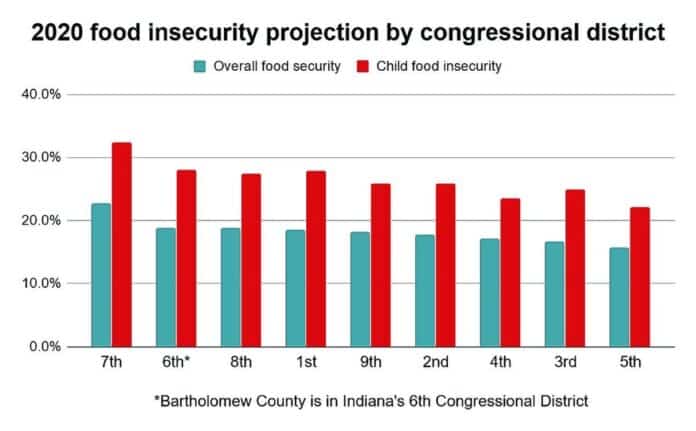Local food pantries say they are seeing a surge in the number of people seeking help with groceries after $600 in weekly federal unemployment aid expired, resulting in the highest one-month increase in demand for food at Love Chapel in the organization’s history and a “huge increase” in people seeking food at Salvation Army.
Last month, Love Chapel served about 4,150 people — an increase of more than 1,100 compared to July and the equivalent of around 5% of Bartholomew County’s population, said Kelly Daugherty, Love Chapel executive director.
The organization distributed about 100,000 pounds of food in August, roughly 1.6 times the weight of all the copper in the Statue of Liberty, up 25,000 pounds from July. Love Chapel distributed 1.2 million pounds of food last year.
“To see that kind of a jump in one month, that’s the first time it has ever been like that,” Daugherty said.
[sc:text-divider text-divider-title=”Story continues below gallery” ]Click here to purchase photos from this gallery
The Salvation Army served around 1,261 people last month, up from 997 in July, which pastor and administrator Amy Tompkins said was “a huge increase” and is “probably one of the highest” numbers of people ever served in a month. The non-profit typically serves 700 to 900 people per month.
Additionally, home deliveries from the Salvation Army, known as “Bags of Hope,” for people who cannot come to Salvation Army to pick up food, were hovering around 25 to 30 per month before the pandemic. That number has since skyrocketed to 175 per month, Tompkins said.
“We have been seeing an increase in people coming for food,” Tompkins said. “We’re averaging at least 35 new families a month.”
Currently, Love Chapel has enough canned goods for the next four to six months, but only has about a two-week supply of dry goods — pasta, rice, noodles, ramen noodles, cereals, peanut butter — which Daugherty described as “pretty low.”
Typically, Love Chapel tries to keep about a month’s supply in stock.
“That category is probably our biggest need right now,” Daugherty said. “We can get orders from Gleaners every two weeks. …We purchase what we need to make sure that folks get the full basket of groceries that they need.”
Tompkins said dry goods and toilet paper are among some of Salvation Army’s biggest needs.
Food insecurity on the rise
The local surge in need for food assistance comes as millions of people around the country who have been thrown out of work because of the COVID-19 pandemic are struggling to afford the basics now that the extra $600 a week in federal unemployment benefits has expired, The Associated Press reported.
Through July, people out of work amid the coronavirus pandemic were receiving $600 a week in federal aid on top of their state unemployment benefits. For many recipients, the $600 federal check exceeded their state benefits and kept them afloat as the economy crumbled.
In addition, a $300-a-week federal jobless benefit from the Trump administration is already running out just weeks after it began and millions of laid-off Americans nearing an end to their state unemployment aid, according to wire reports.
Across the country, more than 13 million people are collecting unemployment benefits, compared to 1.7 million a year ago.
Experts fear that the economic upheaval will erase progress made on food security in the United States since the Great Recession, according to wire reports. It took about a decade for food insecurity levels to return to pre-Great Recession levels, according to the U.S. Department of Agriculture.
The pandemic, however, is projected to push food insecurity well beyond levels seen during the Great Recession, placing an additional 17 million people in the United States, including 7 million more children, at risk of going hungry, according to Feeding America, a nationwide association of 200 food banks and 60,000 food pantries.
Food insecurity is described as a lack of access to enough food for an active, healthy life, according to the U.S. Department of Agricultures
On Wednesday, 550 families lined up in cars to receive food at Columbus Municipal Airport in the latest in a series of monthly food distributions organized by Indianapolis-based Gleaners Food Bank of Indiana. At one point, the line of cars stretched about a half-mile.
Organizers of the food distribution said they ran out of food and plan to bring enough for 600 families next month, said Becky Voelz, a local service manager at Gleaners Food Bank of Indiana.
Gleaners expects the monthly food distributions in Columbus to continue through December.
“Before the pandemic, we didn’t have a mobile pantry in Columbus each month. Our agencies and partners like Love Chapel and Salvation Army were able to take care of the needy,” Voelz said. “Once the pandemic hit and people started getting laid off and losing their jobs … we just saw that the need was so great that (our partners) were not going to be able to keep up with everyone.”
Feeding America projects that food insecurity will dramatically increase in Bartholomew County this year due to pandemic, with one out of every six residents at risk of going hungry, as well as nearly one out of every four children.
By comparison, just over one out of every 10 Bartholomew County residents were food insecure in 2018, including nearly one out of six children, according to the latest figures available from Feeding America.
“It’s staggering,” Daugherty said, referring to the projections.
Beyond the expected increase in need, some of the biggest challenges local food pantry operators are facing include retaining volunteers, who tend to be older and more likely to suffer severe illness from COVID-19, and reaching people in more rural areas of the county.
“It becomes more of a challenge for people who live in rural settings and may not have access to transportation,” said Mark Stewart, United Way of Bartholomew County president. “While there are mobile pantries that serve those areas and the food pantries do a wonderful job of providing those, they are not frequent enough in the more outlying, rural areas.”
Stalemate in Congress
In the meantime, Republicans and Democrats in Congress have remained gridlocked on a new round of pandemic aid as Washington navigates the extraordinary crisis with the nation’s health and economic security at stake.
On Thursday, Senate Democrats blocked legislation that would have extended the Trump administration’s extra $300 payment and provided more money for schools.
The Democrats favor restoring the full $600-a-week jobless benefit as well as more money for states, localities and small businesses, while Republicans have opposed extending the $600 benefit.
A $3 trillion relief bill passed by the Democrat-led House in May has not gained support in the GOP-led Senate.
Rep. Greg Pence, R-Ind., who is from Columbus, voted against the relief measure passed by the House. In July, Pence called federal COVID-19 unemployment relief “a disaster” and suggesting that the $600 per week was “keeping people from coming back to work,” according to The Muncie Star Press.
However, the U.S. job market’s improvement appears to have weakened since the $600 benefit expired, with hiring slowing since June and the latest figures from the Labor Department indicating that companies are still cutting an unusually large number of jobs.
The decline in the total number of Bartholomew County residents drawing jobless aid has slowed over the same time period, and local continued unemployment claims remain about 14.5 times higher than they were at this time last year, according to the Indiana Department of Workforce Development.
Locally, the demand at for food at Love Chapel went “way down” earlier this year once unemployed workers started receiving the extra $600 weekly benefit and the $1,200 stimulus checks, Daugherty said.
Part of the record-breaking increase at Love Chapel last month was due to the number of clients having previously dropped due to federal pandemic aid, he said.
The current increase puts demand at about where it was at the end December, which was the high point last year.
Voelz said participation in Gleaners’ food distributions in Columbus were down earlier this summer due, in part, to not as much publicity about the monthly distributions and the additional federal jobless aid.
“When they were getting the extra $600, we didn’t have as many people coming, which to me showed that people aren’t really out there to cheat the system,” Voelz said.
An increase in need
Without action from Congress, charitable groups worry the food insecurity will continue to worsen across the country, especially with the end of the $600, the expiration of coronavirus-era moratoriums on evictions and other federal aid.
Even food pantries that have not yet experienced a dramatic increase in demand, such as Community Center of Hope, are anticipating an increase in need toward the end of the year.
Chelsea Warriner, executive director of Community Center of Hope, said she is anticipating “an increase in clients and numbers just because of all the federal aid that will stop as we come up on the end of the year.”
“We anticipate seeing a little bit more,” Warriner said. “We’re a smaller community, so usually who’s already here sticks and you only see an increase in five to 10 households.”
But with the prospects of additional federal aid looking dim, some local food pantries are bracing for additional surges in demand in the months to come.
“We’re expecting that our number in August will probably be the lowest of any month going forward at this point in time,” Daugherty said. “We’re expecting at least that many people again each month, if not a little bit higher.”
[sc:pullout-title pullout-title=”Where to find help” ][sc:pullout-text-begin]
- Human Services, Inc. — Provides emergency assistance that is income-based. 4355 E. County Road 600N, Columbus, IN 47203. Contact: 800-296-8026 or (812) 372-8407.
- Indiana National Guard Family Assistance Program — Provides assistance to active duty Guard families or veterans of any branch. 711 N. Pennsylvania St., Indianapolis, IN 46204. Contact: 800-237-2850, Ext. 72694.
- Salvation Army Corps of Bartholomew County — Provides emergency assistance, when funding is available. 2525 Illinois Ave., Columbus, IN 47201. Contact: (812) 327-7118.
- Lincoln Central Neighborhood Family Center — Assistance provided for residents of LCNF service area, only when other assistance is exhausted. 1039 Sycamore St., Columbus, IN 47201. Contact: (812) 379-1630.
- Love Chapel. 292 Center St., Columbus, IN 47201. Contact: (812) 372-9421.
- United Way of Bartholomew County — Can help those in need of assistance connect with other agencies. 1531 13th St., Suite 1100, Columbus, IN 47201. Contact: 2-1-1 or (812) 376-3001.
- Columbus Township Trustee — Provides emergency assistance for township residents. Contact: 812-372-8249. (Columbus City Utilities can also provide contact numbers for trustees of other townships).
[sc:pullout-text-end][sc:pullout-title pullout-title=”United Way COVID-19 relief fund” ][sc:pullout-text-begin]
United Way of Bartholomew County established a COVID-19 relief fund in March and had raised $612,324 as of Wednesday. The fund has been used to help 4,509 people, including 2,579 who received food assistance.
Visit www.uwbarthco.org and www.unitedtoact.org/barthco/united-ways-relief-fund-helps-thousands for more information.
[sc:pullout-text-end][sc:pullout-title pullout-title=”For more photos” ][sc:pullout-text-begin]
For more photos, see therepublic.com.
[sc:pullout-text-end]





